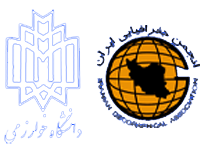دوره 25، شماره 77 - ( 4-1404 )
جلد 25 شماره 77 صفحات 151دوره128فصل__Se |
برگشت به فهرست نسخه ها
Download citation:
BibTeX | RIS | EndNote | Medlars | ProCite | Reference Manager | RefWorks
Send citation to:



BibTeX | RIS | EndNote | Medlars | ProCite | Reference Manager | RefWorks
Send citation to:
Kamran H, Fasihi H. (2025). Investigating the natural and human risks of the historical fabric of Baharestan neighborhood in Tehran. jgs. 25(77), 128-151. doi:10.61186/jgs.25.78.25
URL: http://jgs.khu.ac.ir/article-1-4395-fa.html
URL: http://jgs.khu.ac.ir/article-1-4395-fa.html
کامران دستجردی حسن، فصیحی حبیب اله.(1404). بررسی آسیبهای طبیعی و انسانی بافت تاریخی محله بهارستان در تهران تحقیقات کاربردی علوم جغرافیایی 25 (77) :151-128 10.61186/jgs.25.78.25
1- دانشگاه تهران، دانشگاه تهران
2- دانشگاه خوارزمی، تهران دانشگاه خوارزمی ،fasihi@khu.ac.ir
2- دانشگاه خوارزمی، تهران دانشگاه خوارزمی ،
چکیده: (2808 مشاهده)
بافت تاریخی هر شهر که میراث فرهنگی ملموس و غیرملموس اجتماع شهری را چون نگینی درخشان بر تارک دارد، واجد قابلیتهای ارزشمند برای شکوفایی اقتصاد شهر بوده و رشته پیوند گذشته با حال و آینده را برقرار میسازند. این میراث ارزشمند در معرض تهدیدات و مخاطراتی است که شناسایی آنها گامی بلند در برنامهریزی برای حفاظت از آنها میباشد. هدف این مقاله بررسی مخاطرات طبیعی و انسانی پیش روی بهارستان به عنوان نمونهای از محلههای بافت تاریخی تهران و بررسی وضعیت کالبدی و ساختاری محله برای شناسایی تهدیداتی است که آن را در معرض این مخاطرات قرار میدهد. داده ها از چند فایل GIS و یک پیمایش به دست آمده است. اسناد تاریخی نیز مورد تحلیل قرار گرفتهاند. 20 شاخص مربوط، مورد ارزیابی 30 خبره متخصص به عنوان نمونه آماری قرار گرفتهاند. شاخصهای اسنادی نیز به همین منوال با دادههای پیمایشی منطبق شدهاند. یافته ها بر پتانسیل بالای محله برای مخاطرات طبیعی و انسانی از جمله زمینلرزه، سیل، بادهای شدید، آلودگی هوا و اعتراضات سیاسی دلالت دارند. وضعیت کالبدی، ساختاری و نیز شرایط اجتماعی-اقتصادی مانند ناامنی، توزیع و مصرف مصرف مواد مخدر در فضاهای عمومی، تراکم جمعیت روزانه منجر به مهاجرت ساکنان محله شده و فعالیتهای تجاری و انباری مخاطرهزا جایگزین گردیدهاند. برای حراست از این محله بهعنوان یک میراث فرهنگی، تدوین یک طرح بازآفرینی دقیق که کل بافت تاریخی تهران را یکجا مورد نظر قرار دهد ضروری است.
نوع مطالعه: پژوهشي |
موضوع مقاله:
جغرافیا و برنامه ریزی شهری
فهرست منابع
1. آبراهامیان، پرواند (1390). تاریخ ایران مدرن. تهران. تهران: نشر نی.
2. امرداد نیوز (1402). تصاویر بافت تاریخی تهران. دریافت 11/11/1402 از: https://amordadnews.com/author/homayun9828
3. باستانی راد، حسن (1390). بهارستان در تاریخ تهران. تهران:کتابخانه، موزه و مرکز اسناد مجلس شورای اسلامی.
4. احمدی، سعیده (1395). بررسی دیدگاههای مدیریت بافت تاریخی با تاکید بر الزامات فرهنگی و اجتماعی. تهران: انتشارات مرکز مطالعات و برنامه ریزی تهران.
5. حبیبی، محسن، اهری، زهرا، و امامی، رشید (1390). از فروریختن باروها تا ایده بزرگراه، پیشینه طرح ها و ایده های شهری تهران. صفه، 20(1-2)، 85-102.شهرداری تهران (1396). فایل GIS بافت فرسوده تهران.
6. حنّاچی، پیروز (1400). تهران هر 20 سال یک بار دچار سیل می شود. سایت اعتمادآنلاین. تهران. بازیابی شده در 2/9/1402 از: https://www.etemadonline.com
7. رحیمی، روح ا...، انصاری، مجتبی، بمانیان، محمدرضا، و مهدوینژاد، محمدجواد (1399). رابطه حس مکان و مشارکت و تأثیر آن بر ارتقای سرمایه اجتماعی. مجله معماری شهر پایدار، 8(1). https://www.sid.ir/fa/
8. رمضان زاده لسبویی، مهدی (1396). مبانی و مفاهیم تاب آوری شهری. تهران: انتشارات مرکز مطالعات و برنامهریزی تهران.
9. زنگی آبادی، علی، و تبریزی، نازنین (1385). زلزله تهران و ارزیابی فضایی آسیبپذیری در مناطق شهری. فصلنامه تحقیقات جغرافیایی، 38(56)، 115-130. https://www.sid.ir/fa/journal/ViewPaper.aspx?id=52654.
10. سازمان مدیریت بحران کشور (1400). کجای تهران امن تر است؟ بازیابی 12/11/1402 از: https://tdmmo.tehran.ir/
11. ستاد بازآفرینی پایدار شهر تهران (1401). طرح توسعه محله بهارستان. گزارش منتشر نشده.
12. شهرداری تهران (1395). فایل GIS کاربری اراضی شهری تهران.
13. فصیحی، حبیباله (1386). مروری بر تاریخچه و قابلیت های زلزله در ری. سپهر، 16(62)، 71-78. دریافت از: http://ensani.ir/fa/article
14. قنواتی، ازتاله (1392). پهنه بندی خطر سیل شهر کرج با استفاده از منطق فازی. فصلنامه جغرافیا و مخاطرات طبیعی، 8، 1-14. https://www.sid.ir/fa/journal/ViewPaper.aspx?id=221945.
15. کریمان، حسین (1355). تهران در گذشته و حال. تهران، ایران: انتشارات دانشگاه ملی ایران.
16. مرکز آمار ایران (1395). شیپ فایل بلوکهای آماری سرشماری سال 1395 شهر تهران.
17. مهندسین مشاور باوند (1386). گزارش طرح تفصیلی منطقه 12 تهران.
18. وزارت نیرو (1399). آمار سدهای ایران. دریافت 25/12/1402 از https://moe.gov.ir/
19. وزارت راه و شهرسازی (1393). بافت فرسوده چیست. وزارت راه و شهرسازی ایران. دریافت 12/11/1402 از: www.mrud.ir
20. ویکی پدیا (1399). معترضان به نتایج انتخابات ریاست جمهوری ایران. بازیابی ۲۳/11/1402 ازhttps://fa.wikipedia.org/: https://fa .wikipedia.org/
21. فارسنیوز. (2020). تقویم رویدادهای 1398؛ از اعتراضات مردمی گرفته تا حملات تروریستی. بایابی شده در ۲۳/11/1402از https://www.farsnews.ir
22. Ahmadi, S. (2016). Investigating perspectives of historical fabric management with emphasis on cultural and social requirements. Tehran: Publication of Tehran Studying and Planning Center.(in Persian)
23. Adnan, A., Ramli, M., & Abd Razak, S. (2015). Disaster management and mitigation for earthquakes: Are we ready? 9th Asia Pacific Structural Engineering and Construction Conference, (pp. 34-44). Kuala Lumpur.
24. Allen, S., Barros, V., Burton, L., & Campbel -lendrum, D. (2012). Managing the risks of extreme events and disasters to advance climate change adaptation. special report of working groups I and II of the Intergovernmental Panel on Climate Change. (C. Field , V. Barros, T. Stocker, D. Qin, D. Dokken, K. Ebi, . . . P. Midgley, Eds.) doi:10.13140/2.1.3117.9529
25. Asgari, A., Levy, J., & Mehregand, N. (2007). Estimating willingness to pay for a hypothetical earthquake early warning systems. Journal of Environmental Hazards, 7(4), 312-320. doi:10.1016/j.envhaz.2007.09.003. (in Persian) [DOI:10.1016/j.envhaz.2007.09.003]
26. Bastani-e Rad, H. (2011). Baharestan in History. Tehran, Iran: Library, Museum and Documentation Center of the Islamic Consultative Assembly. (in Persian)
27. Bavand Consulting Engineers. (2007). Detailed plan of Tehran Distric 12. Tehran. (in Persian)
28. Bernard, H., & Adl, S. (1996). Tehran: capitale bicentenaire. Institut Francais de recherche en Iran.
29. Comite, V., Randazzo, L., La Russa, M., & Fermo , P. (2020). A multi-analytical approach for the characterization of black crusts on the facade of an historical cathedral. Microchemical Journal, 158, 12. Retrieved from www.elsevier.com/locate/microc [DOI:10.1016/j.microc.2020.105121]
30. EEA. (2012). Urban adaptation to climate change in Europe: Challenges and opportunities for cities together with supportive national and European policies. European Environment Agency. doi:10.2800/41895
31. fa.wikipedia. (2021). Protesters against the results of the presidential election in Iran. Retrieved 2 3, 2022, from --fa.wikipedia, 2021, Protesters against the results of the presidential election in Iran, Retrieved 10/16/2021 from: https://fa.wikipedia.org/: https://fa.wikipedia.org/(in Persian)
32. Farsnews. (2020). Calendar of November 2019 events; From popular protests to terrorist attacks. Retrieved 2 5, 2022, from https://www.farsnews.ir(in Persian)
33. Fasihi, H. (2007). An overview of the history and capabilities of earthquakes in Ray. Sepehr, 16(62), 71-78. Retrieved from http://ensani.ir/fa/article(in Persian)
34. Ghanavati, E. (2013). Flood risk zoning of Karaj city using fuzzy logic. Journal of Geography and Natural Hazards, 8, 1-14. Retrieved from https://www.sid.ir/fa/journal/ViewPaper.aspx?id=221945. (in Persian)
35. Habibi, M., Ahari, Z., & Emami, R. (2011). From the collapse of fortifications to the idea of highways, the background of urban plans and ideas of Tehran. Soffeh, 20(1-2), 85-102. (in Persian)
36. Hannachi, P. (2021, March 22). Tehran is flooded once every 20 years. Etemadonline Company. Tehran. Retrieved July 02, 2022, from https://www.etemadonline.com (in Persian)
37. Headquarter of Sustainable Regeneration of Tehran . (2020). Development plan of Baharestan neighborhood. Tehran: Headquarter of Sustainable Regeneration of Tehran Megapolis. Retrieved from Headquarter of Sustainable Regeneration of Tehran Megapolis. (in Persian)
38. Ibrahamian, Y. (2011). History of Modern Iran. Tehran. Iran: Ney Publishing. (in Persian)
39. Iranian Statistic Center. (2016). GIS file of Statistic blocks ( 2016 Iranian Public Census of Population and Housing). Retrieved from Iranian Statistic Centerr: https://www.amar.org.ir. (in Persian)
40. Jigyasu, R. (2019). Risk assessment of cultural heritage: : Tools & methodology. Retrieved July 30, 2022, from https://www.nara.accu.or.jp/el/textpdf/Risk_Assessment_of_Cultural_Heritage_Tools_and_Methodology(2019).pdf
41. Kariman, H. (1976). Tehran in the past and present. Tehran, Iran: The Publication of Iranian National University. (in Persian)
42. Laoupi, A., & Tsakiris, G. (2007). Assessing vulnerability in cultural landscapes. EWRA Symposium "Water Resources Management: New Approaches and Technologies, (pp. 14-16).
43. Ministry of Power. (2020). Statistics from Iranian dams. Retrieved 2 10, 2022, from https://moe.gov.ir/ (in Persian)
44. Ministry of Road and Urban Development. (2014). What is worn- out fabric. Iranian Ministry of Road and Urban Development. Retrieved Junuary 12, 2022, from www.mrud.ir
45. Municipality of Tehran. (2016). GIS file of Tehran urban land use. Tehran. (in Persian)
46. Municipality of Tehran. (2017). GIS file of Tehran worned out fabric. (in Persian)
47. Murthy, M. (2013). Heritage and resilience issues and opportunities for reducing disaster risks. UNISDR. Retrieved from https://www.researchgate.net/publication/327906144_HERITAGE_AND_RESILIENCE_Issues_and_Opportunities_for_Reducing_Disaster_Risks
48. Organization for Mitigating & Managing Tehran Disa. (2021). Where is it safer in Tehran? Retrieved 10 15, 2021, from https://tdmmo.tehran.ir/, (in Persian)
49. Rahimi, R., Ansari, M., Bemanian, M., & Mahdavinegad, M. (2019). Relationship between sense of place and participation and its effect on promoting social capital. Journal of Sustainable City Architecture, 8(1). Retrieved from https://www.sid.ir/fa/(in Persian)
50. Ramazanzadeh Lasbooei, M. (2016). Fundamentals and concepts of urban resilience. Tehran: Center for Tehran Studying and Planning Publication. (in Persian)
51. Rebollo, V., & Latinos, V. (2020). Good practices in building cultural heritage resilience. ARCH. Retrieved July 30, 2022, from https://savingculturalheritage.eu
52. Rosu, A., Constantin, D., Arseni, M., & Timofti, M. (2020). Atmospheric measurements in the context of protection and conservation of cultural heritage objects. AIP Conference Proceedings 2218, 030015. doi:10.1063/5.0001827 [DOI:10.1063/5.0001827]
53. Sabbioni, C., Cassar, M., Brimblecombe, P., & Lefe, R. (2008). Vulnerability of cultural heritage to climate change. EUR-OPA major hazards agreement; Council of Europe. Retrieved July 30, 2022, from https://www.coe.int
54. Takmil-e Homayoon, N. (2006). Social and cultural history of Tehran. Tehran. Iran: Cultural Research Office Publications. (in Persian)
55. UNISDR. (2009). 2009 UNISDR terminology on disaster risk reduction. United Nations Office for Disaster Risk Reduction: UNISDR. Retrieved from https://www.undrr.org
56. USGS. (2021). Earthquake Glossary. USGS. Retrieved July 3, 2022, from https://earthquake.usgs.gov
57. USGS. (2021). What are the earthquake hazards/risks where I live? USGS. Retrieved January 11, 2022, from https://www.usgs.gov
58. Wamsle, C., & Brink, E. (2015). The urban domino effect: a conceptualization of cities' interconnection of risk. Lund University, Centre for Sustainability Studies, (LUCSUS). Retrieved from http://www.preventionweb.net/english/hyogo/gar/2015/en/bgdocs/Wamsler%20and%20Brink,%202014.pdf
59. Wamsler, C., & Brink, E. (2014). The urban domino effects: A conceptualization of cities' interconnectedness of risk. The United Nations Office for Disaster Risk Reduction: UNISDER.
60. Worldwatch Institute. (2007). Worldwatch Institute, 2007, State of the world 2007: Our urban future: a Worldwatch Institute report on progress toward a sustainable society. Worldwatch Institute. Retrieved July 30, 2022, from http://www.citet.nat.tn/
61. Zangiabadi, A., & Tabrizi, N. (2006). Tehran earthquake and spatial assessment of vulnerability in urban areas. Geographical Research Quarterly, 38(56), 115-130. Retrieved from https://www.sid.ir/fa/journal/ViewPaper.aspx?id=52654. (in Persian)
ارسال پیام به نویسنده مسئول
| بازنشر اطلاعات | |
 |
این مقاله تحت شرایط Creative Commons Attribution-NonCommercial 4.0 International License قابل بازنشر است. |

This work is licensed under a Creative Commons — Attribution-NonCommercial 4.0 International (CC BY-NC 4.0)






